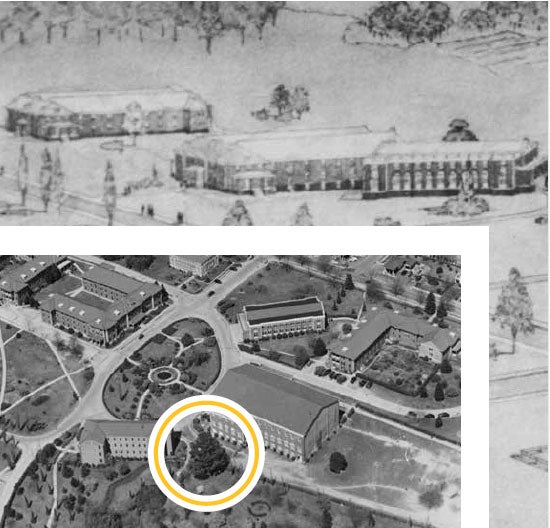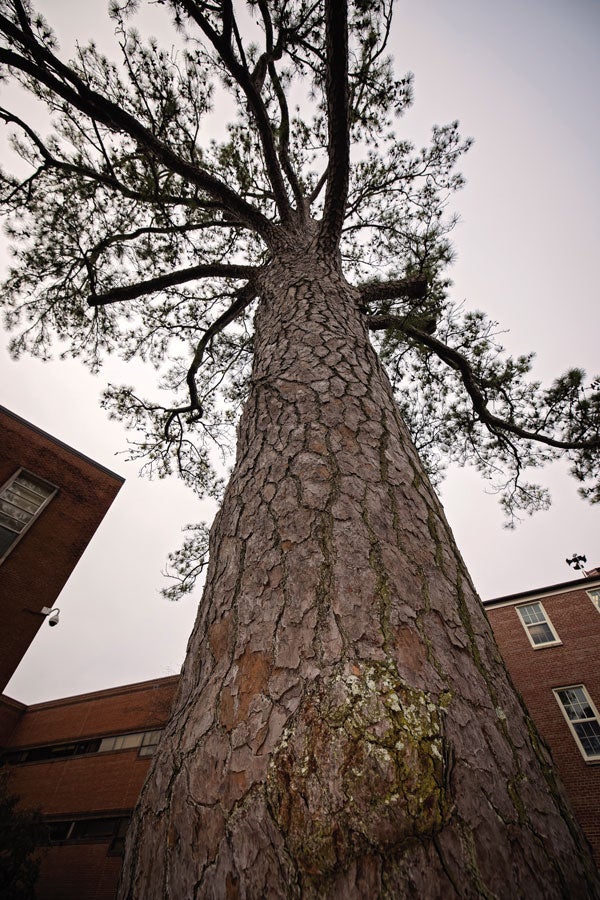Tree Campus

Between the Wright and Graham buildings, protected by a ring of holly bushes, stands an overlooked landmark older than any building on East Carolina University’s campus.
“Any picture that I’ve seen of the university dating all the way back to the turn of the century, that tree was in it,” says John Gill, grounds director. “We have a hedge around it to protect it, so you really don’t get how big it is until you actually walk in there and stand next to it.”
The loblolly pine, a personal favorite of Gill’s, is a highlight of the ECU Tree Trail, a mile-and-a-half circular route through campus featuring 45 species of trees.
The trees are identified with sequentially numbered plaques, and botanical information is provided in a printed brochure or through an interactive app.
These resources are the culmination of years of effort by a diverse group of faculty, staff, students and alumni, Gill says. Key figures include biology professors Claudia Jolls and Carol Goodwillie, former ECU arborist Gene Stano, sustainability manager Chad Carwein, and alumnus Mike Bunting, among others. Graduate student Ashley Dow was instrumental in developing the interactive aspect of the trail, Gill says.
Bunting, an alumnus from Greensboro who passed away in August 2020, was known for attending every home football game for more than 50 years. He established a number of scholarships at ECU and wanted to do something on campus that would combine his love of ECU and of plants and landscaping.
With Bunting’s support and a visit to Elon University’s tree trail for inspiration, the team began to inventory trees, record GPS locations, and put together the descriptions, brochure and app.

An aerial photo of ECU’s campus shows the loblolly pine near Wright Auditorium, already a large tree in 1948. (ECU archives)

Chad Carwein, left, and John Gill talk about the second tree on the ECU Tree Trail, a white oak.
The trail begins with an American holly in front of the Leo W. Jenkins Fine Arts Center and passes a majestic southern magnolia on its way toward Wright Plaza and the foot of College Hill, then leads back through the mall and the Student Memorial Garden. From flowering landscaping trees such as crape myrtle and cherry to stately shade trees such as oaks and elms, the trees add color and interest to the campus throughout the year with springtime blooms and brilliant fall foliage.
“I really think of the tree trail as just a giant outdoor classroom,” says Carwein. “(The app) will pull the location of your phone and tell you what tree you’re standing next to. And then when you click on it, it tells you about the species, whether it’s evergreen or deciduous, whether it’s native or not, and more.”

This loblolly pine stands in Wright Plaza. One of the oldest trees on campus, it appears in some of the earliest photos and drawings of ECU.
Whether it’s a professor holding class outside, college students exploring their environment or grade schoolers visiting ECU’s campus, the trail offers an opportunity to learn and experience the outdoors while getting a little exercise, he says. Carwein suggests allowing an hour to walk the full trail and take a moment to learn about each tree, but with the app it’s easy to just pick out one or a few trees and learn a little bit more about them.
Initiatives like the tree trail and the arboretum in front of Jenkins, along with a concerted effort to care for existing trees and to replace any trees lost to disease, age or construction, have helped earn ECU the Tree Campus USA designation for five years running. Carwein says a key part of the designation is student service-learning, and students have played an important role in studying and cataloging the trees on campus.
“We’re also talking about putting a second arboretum around Lake Laupus on the Health Sciences Campus,” he says.
In addition, a group of students in the Honors College has launched a crowdfunding effort called the Edible Landscape Initiative to establish an orchard so that students can have firsthand experiences in growing a sustainable food source for themselves and others.
Established on 43 acres as East Carolina Teachers Training School in 1907, ECU’s campus has since grown to almost 1,600 acres. Through those years the university has fostered a commitment to environmental stewardship by protecting and preserving the valuable natural resources on campus.
Gill says he’s especially committed to reestablishing the tree canopy over Fifth Street.
“I remember coming in for my interview, and it was just so beautiful with the tree canopy over top of it, and it’s something you don’t see a whole lot of,” he says.
Many of the trees that formed the canopy grew between the sidewalk and the street — not the best place for a tree as it grows larger — and some have been lost. The grounds crew has planted a number of trees to replace them, but behind the hedge instead of next to the street.
“Eventually those trees will get big enough and fill in that canopy again,” Gill says.
The loblolly pine near Wright, along with the oak and pecan trees on the mall and many others, are as much a part of ECU as the fountain and the cupola. They’ve stood over campus as it has changed through the years as thousands of Pirates have passed from class to class, and now there’s a way to mark their place in history.

Above, an artist’s rendering from the early 1900s appears to have included the loblolly pine. (ECU archives)